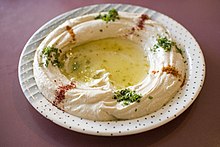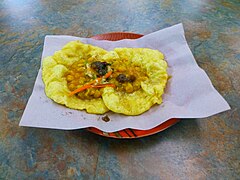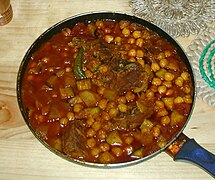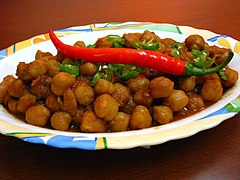grão de bico ou grão de bico ( Cicer arietinum ) é uma leguminosa anual da família Fabaceae , subfamília Faboideae. Seus diferentes tipos são conhecidos como grama ou grama de Bengala, grão de bico ou grão de bico, ou ervilha egípcia
| Grão de bico | |
|---|---|
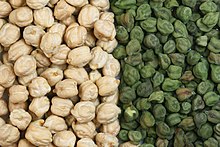 | |
| Os dois tipos principais de grão-de-bico: o maior, de cor castanha clara, Kabuli, e o grão-de-bico Desi de várias cores . São verdes quando colhidos precocemente e variam do castanho-amarelado ou bege, salpicado, do marrom escuro ao preto. 75% da produção mundial é do tipo desi menor . O grão-de-bico maior ou hoummus foi introduzido na Índia no século XVIII. | |
 | |
| Grão de bico germinado | |
| Classificação científica | |
| Reino: | Plantae |
| Clade : | Traqueófito |
| Clade : | Angiospermas |
| Clade : | Eudicots |
| Clade : | Rosids |
| Pedido: | Fabales |
| Família: | Fabaceae |
| Genus: | Cicer |
| Species: | C. arietinum |
| Binomial name | |
| Cicer arietinum | |
| Synonyms[1] | |
| |
O grão de bico ou grão de bico ( Cicer arietinum ) é uma leguminosa anual da família Fabaceae , subfamília Faboideae . [2] [3] Seus diferentes tipos são conhecidos como grama [4] [5] ou grama de Bengala , [5] grão de bico [5] ou grão de bico , ou ervilha egípcia . [4] As sementes de grão de bico são ricas em proteínas . É uma das primeiras leguminosas cultivadas, e restos de 9500 anos foram encontrados no Oriente Médio . [6] [7]
O grão-de-bico é um ingrediente chave no homus e na chana masala , e pode ser moído e transformado em farinha para fazer falafel . Também é usado em saladas, sopas e ensopados, curry e outros produtos alimentares como channa. O grão de bico é importante na culinária indiana , mediterrânea e do Oriente Médio . Em 2019, a Índia era responsável por 70% da produção global de grão de bico.
O nome "grão-de-bico", antes "chiche pease", é modelado no francês médio pois chiche , onde chiche vem do latim cicer . "Chich" era usado sozinho em inglês dos séculos XIV ao XVIII. [9] A palavra garbanzo , de uma alteração do antigo espanhol arvanço , veio primeiro para o inglês como "garvance" no século 17, sendo gradualmente anglicizada para " calavance ", embora tenha passado a se referir a uma variedade de outros grãos, incluindo o feijão jacinto . A forma atual garbanzo vem diretamente do espanhol moderno. [10]
História [ editar ]
Cicer reticulatum é o progenitor selvagem do grão-de-bico e atualmente só cresce no sudeste da Turquia, onde acredita-se que tenham sido dometados. Grãos de bico domesticados foram encontrados em locais do Neolítico B do Pré-Olaria (9900–9550 BP) na Turquia e no Levante , nomeadamente em Çayönü , Hacilar e Tell es-Sultan (Jericó). [11] O grão de bico então se espalhou para a região do Mediterrâneo por volta de 6.000 aC e para a Índia por volta de 3.000 aC. [11]
No sul da França, camadas mesolíticas em uma caverna em L'Abeurador, Hérault , produziram grão -de- bico, datado por carbono de 6790 ± 90 AC. [12] Eles foram encontrados no final do Neolítico (cerca de 3500 aC) locais na Tessália , Kastanas , Lerna e Dimini , Grécia .
Grão de bico são mencionados em Carlomagno 's Capitulare de villis (cerca de 800 DC) como cicer italicum , como crescido em cada demesne imperial . Albertus Magnus menciona variedades vermelhas, brancas e pretas. Nicholas Culpeper observou que "ervilhas ou ervilhas" são menos " ventosas " do que ervilhas e mais nutritivas. Os povos antigos também associavam o grão-de-bico a Vênus porque se dizia que eles ofereciam usos médicos, como aumentar a produção de sêmen e leite, induzir a menstruação e urinar e ajudar no tratamento de pedras nos rins . [13] Os "oficiais brancos" eram considerados especialmente fortes e prestativos.
Em 1793, o grão-de-bico torrado e moído foi considerado por um escritor alemão como um substituto do café na Europa. [14] Na Primeira Guerra Mundial , eles foram cultivados para esse uso em algumas áreas da Alemanha. [15] Eles ainda são feitos às vezes em vez de café. [14]
Sequenciamento do genoma [ editar ]
O sequenciamento do genoma do grão-de-bico foi concluído para 90 genótipos de grão-de-bico, incluindo várias espécies selvagens. [16] Uma colaboração de 20 organizações de pesquisa, lideradas pelo Instituto Internacional de Pesquisa de Culturas para os Trópicos Semi-Áridos ( ICRISAT ), sequenciou o CDC Frontier, uma variedade de grão-de-bico kabuli , e identificou mais de 28.000 genes e vários milhões de marcadores genéticos.
A planta cresce até 20–50 cm (8–20 pol.) De altura e tem folhas pequenas e penugentas em ambos os lados do caule. O grão-de-bico é um tipo de leguminosa , com uma vagem contendo duas ou três ervilhas. Possui flores brancas com veios azuis, violetas ou rosa.
Dezenas de variedades de grão de bico são cultivadas em todo o mundo. Em geral, o grão-de-bico americano e iraniano é mais doce do que o grão-de-bico indiano. O grão de bico Kermanshah nos tamanhos 8 e 9 é considerado um dos de mais alta qualidade do mundo. [18]
Desi chana tem sementes pequenas e mais escuras e uma pelagem áspera. Eles são cultivados principalmente na Índia e em outras partes do subcontinente indiano , bem como na Etiópia , México e Irã . [19] Desi significa "país" ou "nativo" em hindi-urdu ; seus outros nomes incluem kala chana ("grão-de-bico preto" em hindi-urdu) ou bota chholaa . Desi chana pode ser preta, verde ou salpicada. Esta variedade é descascada e dividida para fazer chana dal .
Os grãos-de-bico ou 'kabuli' chana são mais claros, maiores e com uma camada mais lisa, e são cultivados principalmente no Mediterrâneo , Sul da Europa , Norte da África , América do Sul e subcontinente indiano. [19] O nome significa "de Cabul " em hindi-urdu, e acredita-se que essa variedade venha de Cabul, Afeganistão , quando foi introduzida na Índia no século 18. [20] Um grão-de-bico preto incomum, ceci neri , é cultivado apenas na Apúlia e na Basilicata, no sul da Itália. Tem aproximadamente o mesmo tamanho do grão-de-bico, sendo maior e mais escuro do que a variedade 'desi'.
Produção [ editar ]
| País | Produção (milhões de toneladas ) |
|---|---|
9,94 | |
0,63 | |
0,51 | |
0,50 | |
0,45 | |
0,44 | |
Mundo | 14,25 |
| Fonte: FAOSTAT das Nações Unidas [8] | |
Em 2019, a produção mundial de grão de bico foi de 14 milhões de toneladas , liderada pela Índia com 70% do total global e pela Turquia como produtor secundário (tabela).
O grão-de-bico é geralmente fervido rapidamente por 10 minutos e depois cozido por um período mais longo. O grão-de-bico seco precisa de um longo tempo de cozimento (1–2 horas), mas se desfará facilmente quando for cozido por mais tempo. Se ficar de molho por 12–24 horas antes do uso, o tempo de cozimento pode ser reduzido em cerca de 30 minutos. O grão de bico também pode ser cozido sob pressão ou sous vide a 90 ° C (194 ° F).
O grão-de-bico maduro pode ser cozido e comido frio em saladas , cozido em guisados , moído em farinha , moído e moldado em bolas e frito como falafel , feito em uma massa e assado para fazer farinata ou cecina , ou frito para fazer painel . A farinha de grão de bico é conhecida como farinha de grama ou besan no sul da Ásia e usada com frequência na culinária do sul da Ásia .
In Portugal, chickpeas are one of the main ingredients in rancho, eaten with pasta and meat or with rice. They are used in other hot dishes with bacalhau and in soups, meat stews, and salads mixed with tuna and vegetables, olive oil, vinegar, hot pepper and salt. In Spain, they are used cold in tapas and salads, as well as in cocido madrileño.
Hummus é a palavra árabe para grão de bico, que geralmente é cozido e moído em uma pasta e misturado com tahini (pasta de semente de gergelim), a mistura chamada ḥummuṣ bi ṭaḥīna . O grão de bico é assado, temperado e comido como um lanche, como o leblebi . No final do século 20, o homus se tornou comum na culinária americana. [21] Em 2010, 5% dos americanos consumiam homus em uma base regular, [21] e estava presente em 17% dos lares americanos. [22]
O grão de bico e os gramas de Bengala são usados para fazer curries e são um dos alimentos vegetarianos mais populares no subcontinente indiano e nas comunidades da diáspora de muitos outros países, servidos com uma variedade de pães ou arroz cozido no vapor. Os pratos populares da culinária indiana são feitos com farinha de grão de bico, como mirchi bajji e mirapakaya bajji. Na Índia, assim como no Levante , o grão-de-bico verde é freqüentemente retirado da vagem e comido como um lanche cru e as folhas são comidas como verdura em saladas. Na Índia, sobremesas como besan halwa e doces como mysore pak , besan barfi e laddu são feitos.[ citação necessária ]
A farinha de grão de bico é usada para fazer o " tofu birmanês ", que foi conhecido pela primeira vez entre o povo Shan da Birmânia . Na culinária do sul da Ásia, a farinha de grão de bico ( besan ) é usada como massa para cobrir os vegetais antes de fritar para fazer pakoras . A farinha também é usada como massa para cobrir vegetais e carnes antes de fritar, ou frita sozinha, como o panelle (pãozinho), um bolinho de grão-de-bico da Sicília . A farinha de grão de bico é usada para fazer o socca de pão achatado mediterrâneo e chamado panissena Provença, sul da França. É feito de farinha de grão-de-bico cozida, servida em pires, que pode endurecer, cortar em tiras e fritar em azeite de oliva, muitas vezes consumido durante a Quaresma. Na Toscana, a farinha de grão de bico (farina di ceci) é usada para fazer uma panqueca assada no forno: a farinha é misturada com água, óleo e sal. A farinha de grão de bico conhecida como kadlehittu em Kannada é usada para fazer o prato doce Mysorepak .
Nas Filipinas , o grão-de-bico conservado em calda é consumido como doce e em sobremesas, como halo-halo . Judeus de países Ashkenazi tradicionalmente servem grão-de-bico inteiro em uma celebração Shalom Zachar para meninos.
Guasanas or garbanza is a Mexican chickpea street snack. The beans, while still green, are cooked in water and salt, kept in a steamer to maintain their humidity, and served in a plastic bag.
A chickpea-derived liquid (aquafaba) can be used as an egg white replacement to make meringue[23] or ice cream, with the residual pomace used as flour.[24]
Animal feed[edit]
Chickpeas serve as an energy and protein source as animal feed.[25]
Raw chickpeas have a lower trypsin and chymotrypsin inhibitor content than peas, common beans, and soybeans. This leads to higher nutrition values and fewer digestive problems in nonruminants. Nonruminant diets can be completed with 200 g/kg of raw chickpeas to promote egg production and growth of birds and pigs. Higher amounts can be used when chickpeas are treated with heat.[25]
Experiments have shown that ruminants grow equally well and produce an equal amount and quality of milk when soybean or cereal meals are replaced with chickpeas. Pigs show the same performance, but growing pigs experience a negative effect of raw chickpea feed; extruded chickpeas can increase performance even in growing pigs. In poultry diet experiments with untreated chickpeas, only young broilers (starting period) showed worse performance. Fish performed equally well when their soybean or cereal diet was replaced by extruded chickpeas.[25] Chickpea seeds have also been used in rabbit diets.[19]
Secondary components of legumes—such as lecithin, polyphenols, oligosaccharides; and amylase, protease, trypsin and chymotrypsin inhibitors—can lead to lower nutrient availability, and thus to impaired growth and health of animals (especially in nonruminants). Ruminants have generally less trouble digesting legumes with secondary components, since they can inactivate them in the rumen liquor. Their diets can be supplemented by 300 g/kg or more raw chickpea seeds.[25] However, protein digestibility and energy availability can be improved through treatments, such as germination, dehulling, and heat. Extrusion is a very good heat technique to destroy secondary components in legumes, since the proteins are irreversibly denatured. Overprocessing may decrease the nutritional value; extrusion leads to losses in minerals and vitamins, while dry heating does not change the chemical composition.[25]
Nutrition[edit]
| Nutritional value per 100 g (3.5 oz) | |
|---|---|
| Energy | 686 kJ (164 kcal) |
27.42 g | |
| Sugars | 4.8 g |
| Dietary fibre | 7.6 g |
2.59 g | |
| Saturated | 0.27 g |
| Monounsaturated | 0.58 g |
| Polyunsaturated | 1.16 g |
8.86 g | |
| Vitamins | Quantity%DV† |
| Vitamin A equiv. | 0% 1 μg |
| Thiamine (B1) | 10% 0.12 mg |
| Riboflavin (B2) | 5% 0.06 mg |
| Niacin (B3) | 4% 0.53 mg |
| Pantothenic acid (B5) | 6% 0.29 mg |
| Vitamin B6 | 11% 0.14 mg |
| Folate (B9) | 43% 172 μg |
| Vitamin B12 | 0% 0 μg |
| Vitamin C | 2% 1.3 mg |
| Vitamin E | 2% 0.35 mg |
| Vitamin K | 4% 4 μg |
| Minerals | Quantity%DV† |
| Calcium | 5% 49 mg |
| Iron | 22% 2.89 mg |
| Magnesium | 14% 48 mg |
| Phosphorus | 24% 168 mg |
| Potassium | 6% 291 mg |
| Sodium | 0% 7 mg |
| Zinc | 16% 1.53 mg |
| Other constituents | Quantity |
| Water | 60.21 g |
| |
| †Percentages are roughly approximated using US recommendations for adults. Source: USDA FoodData Central | |
| Nutritional value per 100 g (3.5 oz) | |
|---|---|
| Energy | 1,581 kJ (378 kcal) |
62.95 g | |
| Sugars | 10.7 g |
| Dietary fibre | 12.2 g |
6.04 g | |
| Saturated | 0.603 |
| Monounsaturated | 1.377 |
| Polyunsaturated | 2.731 |
9 g | |
| Vitamins | Quantity%DV† |
| Vitamin A equiv. | 0% 3 μg |
| Thiamine (B1) | 41% 0.477 mg |
| Riboflavin (B2) | 18% 0.212 mg |
| Niacin (B3) | 10% 1.541 mg |
| Pantothenic acid (B5) | 32% 1.588 mg |
| Vitamin B6 | 41% 0.535 mg |
| Folate (B9) | 139% 557 μg |
| Vitamin B12 | 0% 0 μg |
| Vitamin C | 5% 4 mg |
| Vitamin E | 5% 0.82 mg |
| Vitamin K | 9% 9 μg |
| Minerals | Quantity%DV† |
| Calcium | 6% 57 mg |
| Copper | 33% 0.656 mg |
| Iron | 33% 4.31 mg |
| Magnesium | 22% 79 mg |
| Manganese | 1015% 21.306 mg |
| Phosphorus | 36% 252 mg |
| Potassium | 15% 718 mg |
| Sodium | 2% 24 mg |
| Zinc | 29% 2.76 mg |
| Other constituents | Quantity |
| Water | 60.21 g |
| |
| †Percentages are roughly approximated using US recommendations for adults. Source: USDA FoodData Central | |
Chickpeas are a nutrient-dense food, providing rich content (20% or higher of the Daily Value, DV) of protein, dietary fiber, folate, and certain dietary minerals, such as iron and phosphorus in a 100 gram reference amount (see adjacent nutrition table). Thiamin, vitamin B6, magnesium, and zinc contents are moderate, providing 10–16% of the DV. Compared to reference levels established by the United Nations Food and Agriculture Organization and World Health Organization, proteins in cooked and germinated chickpeas are rich in essential amino acids such as lysine, isoleucine, tryptophan, and total aromatic amino acids.[26]
A 100-gram (31⁄2-ounce) reference serving of cooked chickpeas provides 686 kilojoules (164 kilocalories) of food energy. Cooked chickpeas are 60% water, 27% carbohydrates, 9% protein and 3% fat (table).[25] 75% of the fat content is unsaturated fatty acids for which linoleic acid comprises 43% of the total fat.[27]
Effects of cooking[edit]
Cooking treatments do not lead to variance in total protein and carbohydrate content.[28][29] Soaking and cooking of dry seeds possibly induces chemical modification of protein-fibre complexes, which leads to an increase in crude fiber content. Thus, cooking can increase protein quality by inactivating or destroying heat-labile antinutritional factors.[28] Cooking also increases protein digestibility, essential amino acid index, and protein efficiency ratio. Although cooking lowers concentrations of amino acids such as tryptophan, lysine, total aromatic, and sulphur-containing amino acids, their contents are still higher than proposed by the FAO/WHO reference.[28] Diffusion of reducing sugars, raffinose, sucrose and others into cooking water reduces or completely removes these components. Cooking also significantly reduces fat and mineral contents. The B vitamins riboflavin, thiamin, niacin, and pyridoxine dissolve into cooking water at differing rates.[28]
Germination[edit]
Germination of chickpeas improves protein digestibility, although at a lower level than cooking. Germination degrades proteins to simple peptides, so improves crude protein, nonprotein nitrogen, and crude fiber content. Germination decreases lysine, tryptophan, sulphur and total aromatic amino acids, but most contents are still higher than proposed by the FAO/WHO reference pattern.[28]
Oligosaccharides, such as stachyose and raffinose, are reduced in higher amounts during germination than during cooking. Minerals and B vitamins are retained more effectively during germination than with cooking. Phytic acids are reduced significantly, but trypsin inhibitor, tannin, and saponin reduction is less effective than cooking.[28]
Autoclaving, microwave cooking, boiling[edit]
Protein digestibility is improved by all treatments of cooking. Essential amino acids are slightly increased by boiling and microwave cooking when compared to autoclaving and germination. Overall, microwave cooking leads to a significantly lower loss of nutrients compared to autoclaving and boiling.
Finally, all treatments lead to an improved protein digestibility, protein efficiency ratio, and essential amino acid index. Microwave cooking seems to be an effective method to prepare chickpeas because of its improvement of nutritional values and its lower cooking time.[28]
Leaves[edit]
In some parts of the world, young chickpea leaves are consumed as cooked green vegetables. Especially in malnourished populations, it can supplement important dietary nutrients, because regions where chickpeas are consumed have been sometimes found to have populations lacking micronutrients.[30] Chickpea leaves have a significantly higher mineral content than either cabbage leaves or spinach leaves.[30] In natural settings, environmental factors and nutrient availability could influence mineral concentrations. Consumption of chickpea leaves may contribute nutrients to the diet.[30]
Research[edit]
Consumption of chickpeas is under preliminary research for the potential to improve nutrition and affect chronic diseases.[29][31]
Heat and micronutrient cultivation[edit]
Agricultural yield for chickpea is often based on genetic and phenotypic variability which has recently been influenced by artificial selection.[32] The uptake of micronutrients such as inorganic phosphorus or nitrogen is vital to the plant development of Cicer arietinum, commonly known as the perennial chickpea.[33] Heat cultivation and micronutrient coupling are two relatively unknown methods that are used to increase the yield and size of the chickpea. Recent research has indicated that a combination of heat treatment along with the two vital micronutrients, phosphorus and nitrogen, are the most critical components to increasing the overall yield of Cicer arietinum.[33]
Perennial chickpeas are a fundamental source of nutrition in animal feed as they are high sources of energy and protein for livestock. Unlike other food crops, the perennial chickpea shows a remarkable capacity to change its nutritional content in response to heat cultivation. Treating the chickpea with a constant heat source increases its protein content almost threefold.[33] Consequently, the impact of heat cultivation not only affects the protein content of the chickpea itself, but the ecosystem that it supports as well. Increasing the height and size of chickpea plants involves using micronutrient fertilization with varying doses of inorganic phosphorus and nitrogen.[34]
The level of phosphorus that a chickpea seed is exposed to during its lifecycle has a positive correlation relative to the height of the plant at full maturity.[34] Increasing the levels of inorganic phosphorus at all doses incrementally increases the height of the chickpea plant. Thus, the seasonal changes in phosphorus soil content as well as periods of drought that are known to be a native characteristic of the dry Middle-Eastern region where the chickpea is most commonly cultivated have a strong effect on the growth of the plant itself. Plant yield is also affected by a combination of phosphorus nutrition and water supply, resulting in a 12% increase in yield of the crop.[34]
Nitrogen nutrition is another factor that affects the yield of Cicer arietinum, although the application itself differs from other perennial crops with regards to the levels administered on the plant. High doses of nitrogen inhibit the yield of the chickpea plant.[35] Drought stress is a likely factor that also inhibits the uptake of nitrogen and subsequent fixation in the roots of Cicer arietinum. The growth of the perennial chickpea is dependent on the balance between nitrogen fixation and assimilation that is also characteristic of many other agricultural plant types. The influence of drought stress, sowing date, and mineral nitrogen supply all have an effect on the yield and size of the plant, with trials showing that Cicer arietinum differed from other plant species in its capacity to assimilate mineral nitrogen supply from soil during drought stress.[35] Additional minerals and micronutrients make the absorption process of nitrogen and phosphorus more available. Inorganic phosphate ions are generally attracted towards charged minerals such as iron and aluminium oxides.[36]
Additionally, growth and yield are also limited by zinc and boron deficiencies in the soil. Boron-rich soil resulted in an increase of chickpea yield and size, while soil fertilization with zinc seemed to have no apparent effect on the chickpea yield.[37]
Pathogens[edit]
Pathogens in chickpeas are the main cause for yield loss (up to 90%). One example is the fungus Fusarium oxysporum f.sp. ciceris, present in most of the major pulse crop-growing areas and causing regular yield damages between 10 and 15%.[38]
From 1978 until 1995, the worldwide number of pathogens increased from 49 to 172, of which 35 have been recorded in India. These pathogens originate from the groups of bacteria, fungi, viruses, mycoplasma and nematodes and show a high genotypic variation. The most widely distributed pathogens are Ascochyta rabiei (35 countries), Fusarium oxysporum f.sp. ciceris (32 countries) Uromyces ciceris-arietini (25 countries), bean leafroll virus (23 countries), and Macrophomina phaseolina (21 countries).[39] Ascochyta disease emergence is favored by wet weather; spores are carried to new plants by wind and water splash.[40]
The stagnation of yield improvement over the last decades is linked to the susceptibility to pathogens.[41] Research for yield improvement, such as an attempt to increase yield from 0.8 to 2.0 tons per hectare by breeding cold-resistant varieties, is always linked with pathogen-resistance breeding as pathogens such as Ascochyta rabiei and F. o. f.sp. ciceris flourish in conditions such as cold temperature. Research started selecting favourable genes for pathogen resistance and other traits through marker-assisted selection. The use of this method is a promising sign for the future to achieve significant yield improvements.[42]



